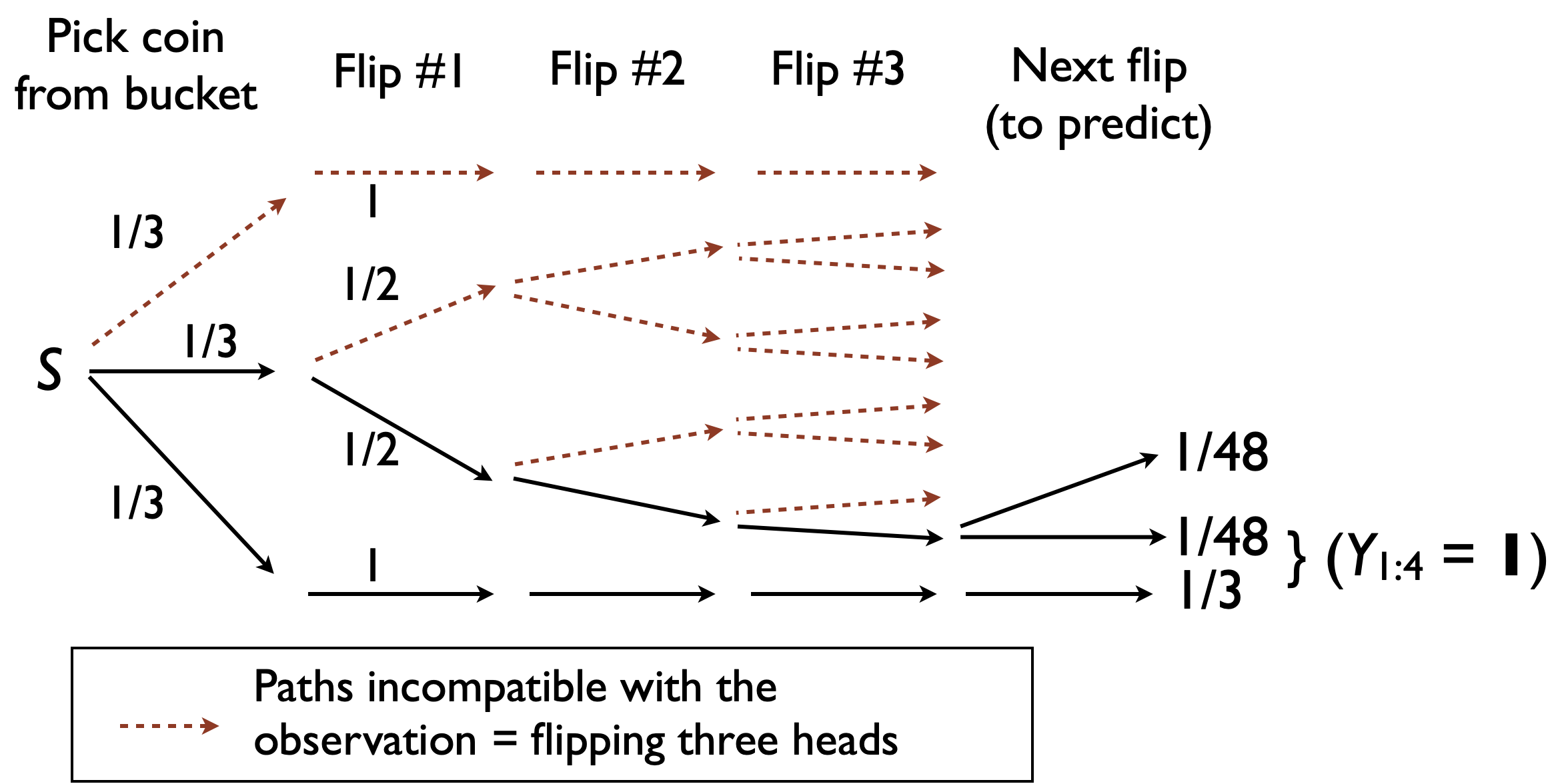Prediction
Outline
Topics
- Prediction using decision trees
- Example
Rationale
Often we do not care so much about “parameters” but instead about predicting future observations.
Example: coins in a bag
Consider the setup from last week with 3 coins and 3 flips with \(Y = (1, 1, 1)\) (in the following, let \(\boldsymbol{1}\) denote a vector of 1’s).
Question: given you have see 3 heads, what is the probability that the next one is also heads?
Mathematically: \(\mathbb{P}(Y_4 = 1 | Y_{1:3} = \boldsymbol{1})\). This is known as “prediction”.
General approach
Key message: In Bayesian statistics, prediction and parameter estimation are treated in the exact same way!
Idea: Add \(Y_4\) to the unobserved random variables, i.e. set \(\tilde X = (X, Y_4)\).
Then, to compute \(\mathbb{P}(Y_4 = 1 | Y_{1:3} = \boldsymbol{1})\) use same techniques as last week (decision tree, chain rule, axioms of probability).
Example, continued
Use the following picture to help you computing \(\mathbb{P}(Y_4 = 1 | Y_{1:3} = \boldsymbol{1})\).

Notation: let \(\gamma(i) = \mathbb{P}(Y_{1:3} = \boldsymbol{1}, Y_4 = i)\).
Question: compute \(\gamma(0)\).
- \(\approx 0.02\)
- \(\approx 0.06\)
- \(\approx 0.52\)
- \(\approx 0.94\)
- None of the above
- There is only one way to get \((Y_{1:3} = \boldsymbol{1}, Y_4 = 0)\): this has to be the standard coin, i.e., \[(Y_{1:3} = \boldsymbol{1}, Y_4 = 0) = (X = 1, Y_{1:3} = \boldsymbol{1}, Y_4 = 0)\]
- To compute the probability of that path we can multiply the edge probabilities (why?): \[\gamma(0) = \mathbb{P}(X = 1, Y_{1:3} = \boldsymbol{1}, Y_4 = 0) = (1/3) \times (1/2)^4 = 1/48 \approx 0.02.\]
Question: compute \(\gamma(1)\).
- \(\approx 0.11\)
- \(\approx 0.35\)
- \(\approx 0.52\)
- \(\approx 0.94\)
- None of the above
- Twist: two distinct paths are compatible with the event: \[(Y_{1:4} = \boldsymbol{1}) = (X = 2, Y_{1:4} = \boldsymbol{1}) \cup (X = 1, Y_{1:4} = \boldsymbol{1}).\]
- Sum the probabilities of the paths leading to the same prediction (why can we do this?).: \[\begin{align*} \mathbb{P}(Y_{1:4} = \boldsymbol{1}) &= \mathbb{P}(X = 2, Y_{1:4} = \boldsymbol{1}) + \mathbb{P}(X = 1, Y_{1:4} = \boldsymbol{1}) \\ &= 1/48 + 1/3 \approx 0.35. \end{align*}\]
Question: compute the predictive
- \(\approx 0.94\)
- \(\approx 0.52\)
- \(\approx 0.35\)
- \(\approx 0.11\)
- None of the above
Let: \[\pi(i) := \mathbb{P}(Y_4 = i | Y_{1:3} = \boldsymbol{1}).\]
Note: \[\pi(i) \propto \gamma(i).\]
Hence: \[(\pi(0), \pi(1)) = \frac{(\gamma(0), \gamma(1))}{\gamma(0) + \gamma(1)}.\] Therefore we get: \[\mathbb{P}(Y_4 = 1|Y_{1:3} = \boldsymbol{1}) = \frac{\gamma(1)}{\gamma(0) + \gamma(1)} = 17/18 \approx 0.94.\]